Ready to count some vowels in a string? Good, because we are going to the best ways to go about it.
Counting vowels in a string is an essential programming skill, particularly for text-processing tasks and natural language processing (NLP) applications.
Sure, there are many ways, but here are the 8 best.
The 8 best methods are:
Using len() and a Loop
Using List Comprehension and filter()
Using Regular Expressions (re package)
Using Python’s Collections Counter
Using set() function
Using a Counter Dictionary with All Vowels
Using List Comprehension and len()
Using a Lambda Function and the filter() Method
In this tutorial, we will explore multiple approaches to count vowels in Python, such as using functions like len(), for loops, list comprehension & filter, and Python’s powerful package re (regular expressions).
Let’s get started.
1. Using Python Vowel Counter

The most efficient way to count vowels in a string in Python is to use built-in string methods and collections counters.
Python collections library provides Counter(), a unique dictionary subclass that allows you to count specific elements’ frequency in an iterable object.
4 steps to count the vowels in a string:
Define a function, such as vowel_counter(), that accepts a single argument: the input string.
To ensure that the function recognizes both uppercase and lowercase vowels, convert the entire string into lowercase.
Use collections.Counter() with a default value of 0 as your counter. Then, iterate through the string to increment the count for each vowel encountered.
Finally, return the counter variable from your function.
How to Use the Python Counter
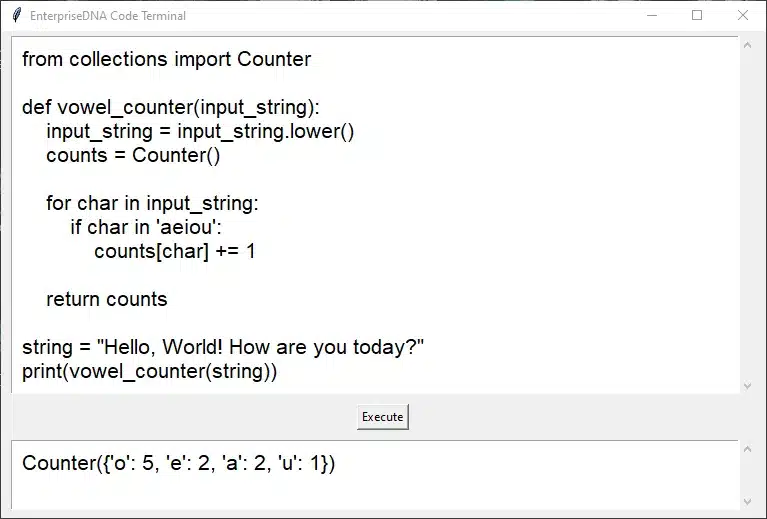
This code demonstrates how you can utilize third-party libraries to achieve your goal more efficiently and elegantly.
Assumptions and Limitations
When using this approach, it is essential to note some assumptions and limitations:
This Method counts all occurrences of each vowel letter separately. For example, it does not consider “ae” as a single occurrence of a diphthong.
It treats all letters (including uppercase and lowercase) as separate units for counting.
The result is presented as a dictionary-like object, where each vowel is a key, and its Count is the corresponding value.
Now, let’s dive into Python’s methods for counting vowels in strings, starting with len() and loops for a fundamental approach.
2. Using a Loop Method

A loop structure continuously counts the vowels in a given string. It iterates through each character of the string and increments a counter variable if it finds a vowel.
5 steps to count vowels using a loop:
Create an empty list, dictionary (or any other appropriate data structure).
Iterate through each character in the string using a for loop.
For each character, check if it is a vowel (a, e, i, o, or u).
If it is a vowel, append it to the list or dictionary (or increment its Count).
After the loop finishes, return the resulting list, dictionary (or any other required output).
Let’s take a look at an example of the loop method.
How to Use the Loop Method
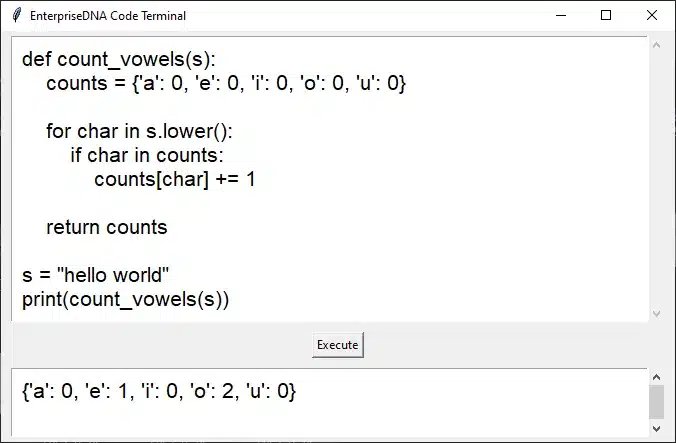
In this example, we have made use of the list data structure.
This counter method allows us to store duplicate values as keys along with their respective occurrence as values.
Now, let’s see how to do it using a simple list structure.
Using List Data Structure
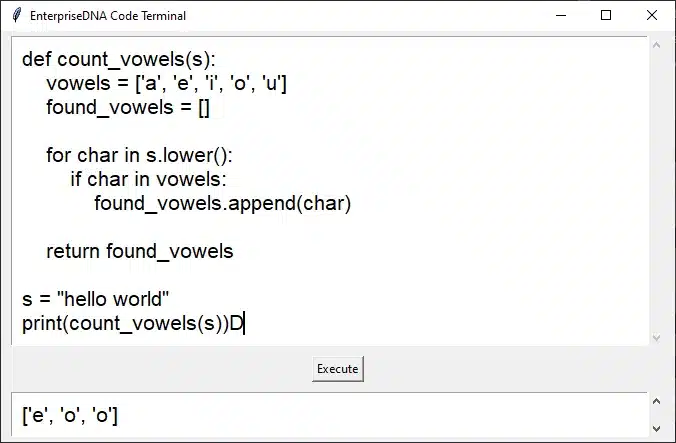
In this example, lists are utilized as they operate on principles similar to dictionaries in this context.
Moving on, we delve into regular expressions, a powerful tool in Python for pattern matching and text processing.
3. Regular Expressions

Regular expressions are valuable for working with strings in various programming languages.
They allow you to search for and manipulate text based on patterns, simplifying tasks like counting vowels.
4 simple steps to count vowels with regex
Regular expressions in Python are available through the re module, which you must import before using its functionalities.
Create a regular expression pattern that matches all vowels. This pattern is [aeiouAEIOU], which includes all lowercase and uppercase vowels.
Apply the re.findall() method with the vowel pattern and the string you want to search. This method returns a list of all pattern occurrences in the string.
Use the len() function to count the number of elements in the list returned by re.findall(), equal to the number of vowels in the string.
Next, let’s see how you can measure the length using regex.
How to Use Regular Expressions

This method is concise and efficient for counting vowels using regular expressions.
Having explored the efficiency of regular expressions, let’s now shift our focus to the translate method in Python for an alternative strategy in vowel counting.
4. Using the translate method

Now, we’re going to explore counting vowels in a string using the translation method in Python.
3 steps to count vowels with the translate method
Create a translation table using the str.maketrans() function. In this table, map each non-vowel character to None. This means you only keep the vowels in your translation table.
Use the translate() method on your string, passing the translation table you created. This method will remove all non-vowel characters from the string, leaving only vowels.
The number of vowels is the length of the string after applying the translate() method. You can use the len() function to get this count.
The number of vowels can be determined by subtracting the length of the original string from that of the stripped string.
Let’s take a quick look at an example.
How to count vowels using Python’s translation method
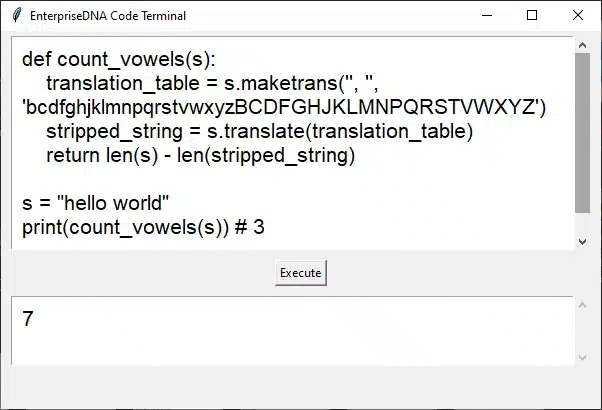
This approach is efficient regarding time complexity as it processes the string in a single step. It also does not require an explicit loop, making it more concise and potentially faster for large strings.
Let’s now turn to the set() function, demonstrating a unique approach to counting vowels in Python with distinctiveness.
5. Using set() function

Python set() function to count vowels in a string. Sets are data structures in Python that store unique elements. We can use this property to measure the distinctive vowels in the string.
6 steps to count vowels using the set() function
Initialize an empty set to store particular vowels.
Iterate through each character in the string.
Convert each character to lowercase to handle both uppercase and lowercase vowels.
Check if the character is a vowel (i.e., ‘a’, ‘e,’ ‘i’, ‘o’, or ‘u’).
If it’s a vowel, add it to the set.
After the loop finishes, return the length of the set, which represents the Count of unique vowels.
Now, let’s look at an example of how to use it.
How to use the set() function
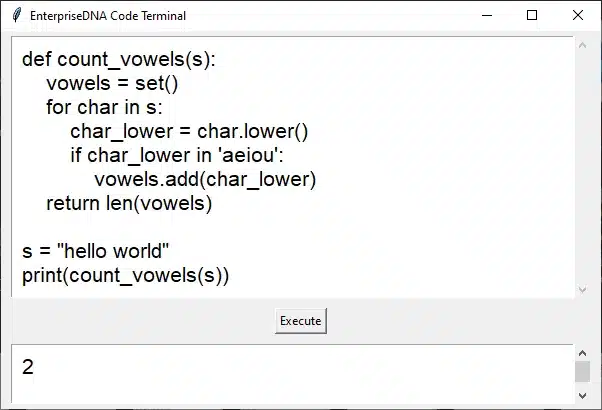
This method counts unique vowels in a string, ignoring repeated occurrences.
Also, you can modify the code to use a data structure if you want to count all occurrences of each vowel.
Next, we explore using a Counter Dictionary with all vowels, offering a comprehensive view of vowel occurrences in a string.
6. Using a Counter Dictionary with All Vowels

In this method, you can use a dictionary to count all the vowels (uppercase and lowercase) in a given string. This approach allows you to handle different variations of vowels efficiently.
5 Steps to use a Counter dictionary in Python
First, import the Counter class from the collections module. This class is specifically designed for counting hashable objects.
Define a list of all vowels, both uppercase and lowercase. This list will include ‘A,’ ‘E,’ ‘I,’ ‘O’, ‘U,’ ‘a’, ‘e,’ ‘i’, ‘o’, ‘u’.
Employ list comprehension to filter out the vowels from the given string. This is done by iterating through each character in the string and checking if it is in the vowel list.
Pass the list of vowels obtained from the string to the Counter class. This will create a Counter dictionary where each vowel is a key, and its count in the string is the value.
Finally, use the sum() function along with the Counter.values() method to get the total vowel count in the string.
Okay, now let’s take a look at how to implement this.
How to use the counter dictionary
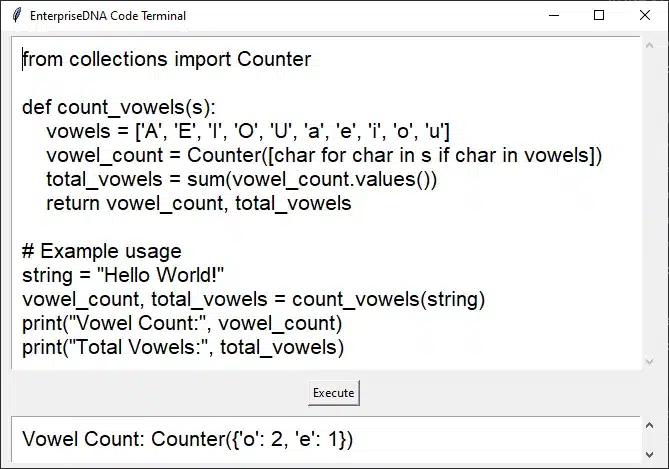
This Method counts uppercase and lowercase vowels and provides the total number of vowels in the string.
Advancing to list comprehension and len(), we see how these Python staples can simplify counting vowels in strings.
7. Using List Comprehension and len()

List comprehensions are a concise way to create lists in Python. You can use list comprehension to count vowels and then calculate the length of the resulting list to get the Count.
3 Steps to count vowels in a string using list comprehension and len()
Define a list containing all vowels, uppercase and lowercase (‘A,’ ‘E,’ ‘I,’ ‘O’, ‘U,’ ‘a’, ‘e,’ ‘i’, ‘o’, ‘u’).
Use list comprehension to iterate over each character in the given string. In this comprehension, include a condition to check if each character is a vowel (i.e. if it’s in the vowels list).
The list comprehension results in a list of vowels found in the string. Use the len() function to count the number of elements in this list, which gives the number of vowels in the string.
Let’s take a look at an example of how to use it.
How to use list comprehension and len()
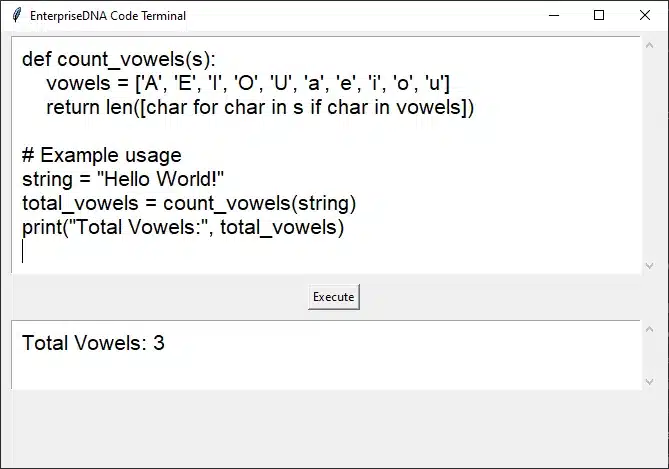
This Method uses list comprehension to create a list of vowels and then calculates the length of the list.
Now, we’ll combine a lambda function and the filter() method, showcasing Python’s versatility in processing textual data.
8. Using a Lambda Function and the filter() Method

Python’s filter() method can be combined with a lambda function to filter out vowels from the string, and then you can calculate the Count.
3 Steps to count vowels using a lambda function and filter()
Define a lambda function that checks if a character is a vowel. This function should take one character as input and return True if it’s a vowel (uppercase or lowercase) and False otherwise.
Use the filter() method with your lambda function and the string you’re examining. This method will go through each character in the string and keep only those that the lambda function identifies as vowels.
Convert the result from the filter() method (which is an iterator) into a list. Then, use the len() function to count the number of items in this list, representing your string’s total number of vowels.
Here’s a quick example in Python:
How to use the Lambda function and filter() method
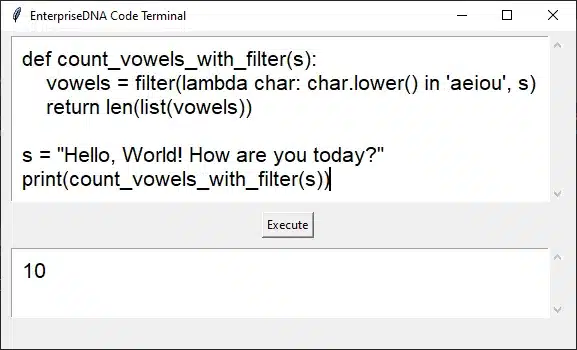
This Method uses a lambda function within the filter() Method to filter vowels and then converts the filtered result into a list for counting.
These additional methods provide different ways to count vowels in a string, allowing you to choose the one that suits your specific needs and coding preferences.
Having explored diverse vowel-counting techniques in Python, let’s now reflect on our main points.
Final Thoughts
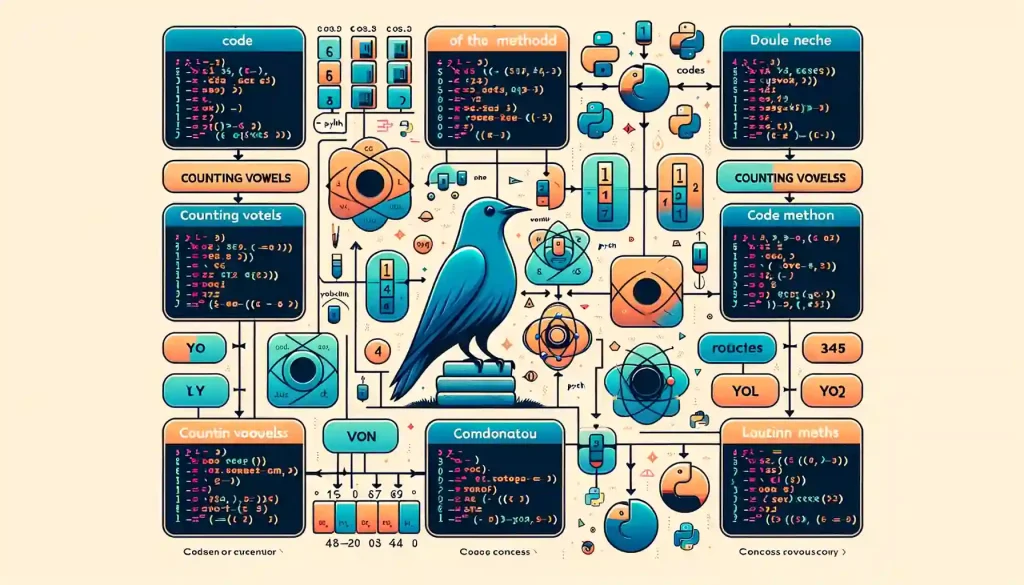
Counting vowels in strings is essential for text analysis and natural language processing in Python.
While learning this concept may seem straightforward, it is necessary to understand the different methods for this task.
This detailed guide explored various ways, including filter(), list comprehension, built-in functions, and regular expressions. We also looked at multiple examples that showcased these methods, demonstrating their utility while incorporating multiple vowels into our analysis.
Moreover, we dived into how to make our programs more efficient by comparing different strategies. Through comparison, we found that built-in functions can deliver better results!
Learning different methods for counting vowels will enhance your understanding of programming language and text analysis skills and provide a solid foundation for more advanced concepts in Python programming.
Good luck with your vowel-counting adventures!
For the latest AI tool that simplifies Python functions, be sure to check out EnterpriseDNA’s YouTube channel.
Frequently Asked Questions
How can I count the number of vowels in a string using Python?
To count the number of vowels in a string using Python, you can use various methods such as loops, regular expressions, or Python libraries like collections. Each Method involves iterating through the string and keeping a count variable to track the number of vowels.
What is the most efficient way to count vowels in a string in Python?
The most efficient way to count vowels in a string in Python is to use the collections library’s Counter class and a loop to iterate through the string. This approach is efficient and concise.
How do I use Python to count uppercase and lowercase vowels in a string?
To count uppercase and lowercase vowels in a string, you should convert the entire string to lowercase (or uppercase) before counting. This ensures that the program treats both cases of vowels as the same.
What is the ‘re’ module, and how can I use it to count vowels in a string in Python?
The re-module in Python is used for regular expressions. You can use the re.findall() method with the regular expression pattern [aeiouAEIOU] to find all vowels in a string and then use len() to count them.
Explain the use of the ‘str’ method to count vowels in a string in Python.
The str Method can count vowels in a string by creating a translation table with the str.maketrans() function. The method works by removing non-vowel characters from the string and then calculating the length of the resulting string to determine the number of vowels.
How can I determine the total number of vowels present in a given word or sentence using Python?
You can determine the number of vowels in a given word or sentence in Python by looping through the string, regular expressions, or the collections library’s Counter class. Each Method allows you to count the vowels and provide the total number.
Are there any code blocks or if statements involved in counting vowels in Python?
Yes, when counting vowels in Python, you typically use for loops or if statements to iterate through the characters in the string and check if they are vowels. These code blocks are used to increment a count variable or update a data structure to keep track of the vowel counts.
Could you provide a Python program to count the number of vowels in a user’s input string?
Certainly! You can create a Python program that prompts the user to enter a string, and then you can use the same methods mentioned earlier to count the vowels in the user’s input string.
Is there a Python program to count the number of vowels in a given string for data analysis?
You can use the same Python program in the previous answer to count the number of vowels in a given string. This program can be used for various purposes, including data analysis, by processing the input string and calculating vowel counts.
What is the basic approach to counting vowels in a string in Python?
To count vowels in a string in Python, you typically iterate through each character in the string and check if it’s a vowel. This can be done using a loop and an if statement (If Statement 0/2) to compare each character against the vowel set ‘a’, ‘e,’ ‘i’, ‘o’, ‘u’ (E I O U 0/9).








